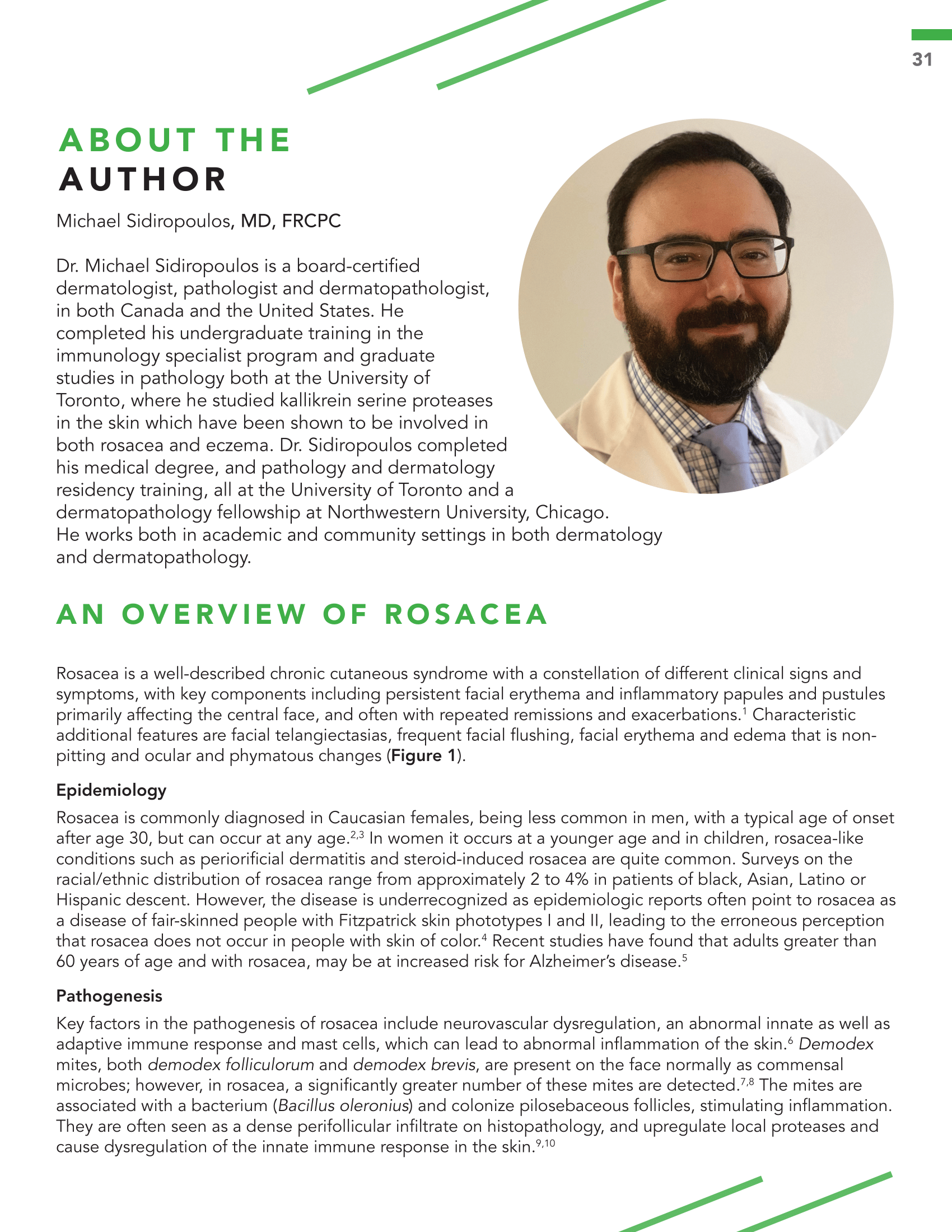An Overview of Rosacea
Abstract
Rosacea is a well-described chronic cutaneous syndrome with a constellation of different clinical signs and symptoms, with key components including persistent facial erythema and inflammatory papules and pustules primarily affecting the central face, and often with repeated remissions and exacerbations. Characteristic additional features are facial telangiectasias, frequent facial flushing, facial erythema and edema that is non-pitting and ocular and phymatous changes.
References
Bolognia JL, Schaffer JV, Cerroni L. Dermatology. 2-set 4th ed. p. 604–614.
Berg M, Liden S. An epidemiological study of rosacea. Acta Derm Venereol. 1989;69(5):419-423.
McAleer MA, Fitzpatrick P, Powell FC. The prevalence and pathogenesis of rosacea. Poster presented at: 88th Annual Meeting of the British Association of Dermatologists; July 1-4, 2008; Liverpool, United Kingdom.
Alexis AF, Callender VD, et al. Global epidemiology and clinical spectrum of rosacea, highlighting skin of color: review and clinical practice experience. Journal of the American Academy of Dermatology. 2019;80(6)1722-1729.
Egeberg MD, Hansen PR, Gislason GH, Thyssen JP. Patients with rosacea have increased risk of dementia. Ann Neurol. 2016;79:921-8.
Wilkin J, Dahl M, Detmar M, et al. Standard classification of rosacea: Report of the National Rosacea Society Expert Committee on the Classification and Staging of Rosacea. J Am Acad Dermatol. 2002;46:584-7.
Bonnar E, Eustace P, Powell FC. The Demodex mite population in rosacea. J am Acad Dermatol. 1993;28:443-8.
Forton, F, Seys B. Density of Demodex folliculorum in rosacea: A case-control study using a standardised skin surface biopsy. Br J Dermatol. 1993;128:650-9.
Lacey N, Delaney S, Kavanagh K, Powell FC. Mite-related bacterial antigens stimulate inflammatory cells in rosacea. Br J Dermatol. 2007;157:474-81.
Lacey N, Ni Raghallaigh S, Powell FC. Demodex mites – commensals, parasites or mutualistic organisms? Dermatology. 2011;222:128-30.
Thiboutot D, Anderson R, Cook-Bolden F, et al. Standard management options for rosacea: The 2019 update by the National Rosacea Society Expert Committee. J Am Acad Dermatol. 2020;82(6):1501-1510.
Browning DJ, Proia AD. Ocular rosacea. Surv Ophthalmol. 1986;31:145-158.
Tan, Jerry, et al. Updating the diagnosis, classification and assessment of rosacea: recommendations from the global ROS acea CO nsensus (ROSCO) panel. British journal of dermatology 176.2 (2017): 431-438.
Michaels JD, Cook-Norris RH, Lehman JS, Gibson LE. Adult with popular eruption o the central aspect of the face. J Am Acad Dermatol 2014;71:410-12.
Del Rosso JQ, Baum EW. Comprehensive medical management of rosacea; an interim study report and literature review. J Clin Aesthet Dermatol 2008;1:20-5.
Powell FC. Rosacea. N Eng J Med 2005; 352:793-803.
Pelle MT, Crawford GH, James WD. Rosacea: II. Therapy. J Am Acad Dermatol 2004; 51:499- 512.
National Rosacea Society. Rosacea Patients Feel Effects of Their Condition in Patient Setting. Rosacea Review. Fall 2012 issue. Available at https://www.rosacea.org/rr/2012/ fall/article_3php. Accessed March 1, 2017.
Haliou B, Cribier B, Frey M, et al. Feelings of stigmatization in patients with rosacea. J Eur Acad Dermatol Venereol. 2017;31:163-168.
National Rosacea Society. Rosacea Triggers Survey. Available at https://www.rosacea.org/ patients/materials/triggersgraph.php. Accessed July 6, 2018.
Preshaw PM, Hefti AF, Jepsen S, et al. Subantimicrobial dose doxycycline as adjustive treatment for periodontitis: a review. J Clin Periodontol. 2004;31:697-707.
Logger, J, Olydam JI, Driessen R. Use of beta-blockers for rosacea-associated facial erythema and flushing: A systematic review and update on proposed mode of action. J Am Acad Dermatol 2020; 83(4):1088-1097.
Wladis EJ, Bradley EA, Bilyk JR, et al. Oral antibiotics for meibomian glad-related ocular surface disease: a report by the American Academy of Ophthalmology. Ophthalmology. 2016; 123:492-496.
Two AM, Wu W, Gallo RL, et al. Rosacea: Part II. Topical and systemic therapies in the treatment of rosacea. J Am Acad Dermatol. 2015;72:761-770.
Zandian M, Rahimian N, Soheilifar S. Comparison of therapeutic effects of topical azithromycin solution and systemic doxycycline on posterior blepharitis. Int J Ophthalmol. 2016; 9:1016-1019.
Shim TN, Abdullah A. The effect of pulsed dye laser on the dermatology life quality index in erythematotelangiectactic rocasea patients. J Clin Aesth Dermatol. 2013; 4:30-32.
Tan SR, Tope WD. Pulsed dye laser treatment of rosacea improves erythema symptomatology, and quality of life. J Am Acad Dematol. 2004; 51:592-599.
Arita R, Fukuoka S, Morishige N. Therapeutic efficacy of intense pulsed light in patients with refractory meibomian gland dysfunction. Ocul Surf.2019; 17 (1): 104-110.
Zhang X, Song N, Gong L. Therapeutic effect of intense pulsed light on ocular demodicosis. Curr Eye Res. 2019; 44: 250-256.
Vora GK, Gupta PK. Intense pulsed light therapy for the treatment of evaporative dry eye disease. Curr Opin Ophthalmol. 2015;26 (4):314-318.
Hagen KB, Bedi R, Blackie CA, et al. Comparison of a single-dose vectored thermal pulsation procedure with a 3 month course of daily oral doxycycline for moderate-to-severe meibomian gland dysfunction. Clin Ophthalmol.2018; 17:161-168.


